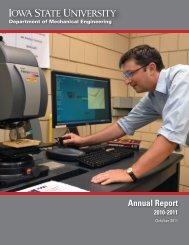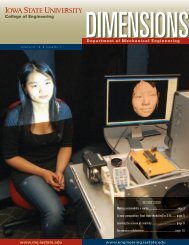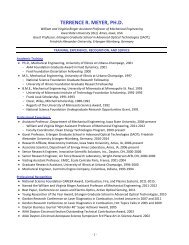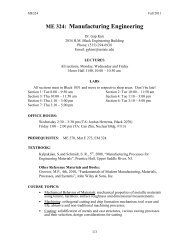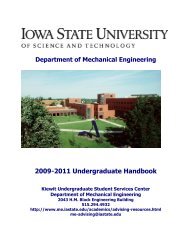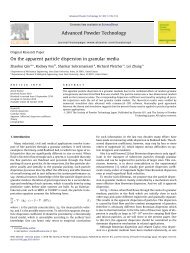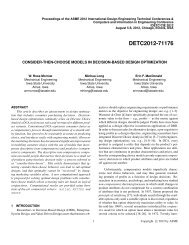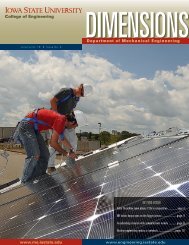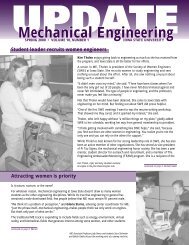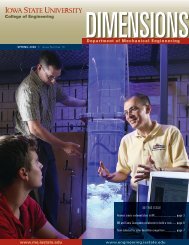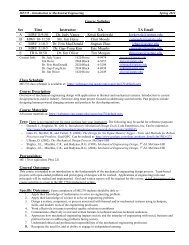Fall 2007 - Mechanical Engineering - Iowa State University
Fall 2007 - Mechanical Engineering - Iowa State University
Fall 2007 - Mechanical Engineering - Iowa State University
- No tags were found...
You also want an ePaper? Increase the reach of your titles
YUMPU automatically turns print PDFs into web optimized ePapers that Google loves.
ME welcomes three new faculty membersWhen LeAnn Faidley moved to Ames in August2006 to begin her position as an assistantprofessor, it was a homecoming of sorts.Until age 18, she had lived her entire life inRome, Italy, where her father worked for theU.N. Food and Agricultural Organization.But family ties helped influence Faidley toattend <strong>Iowa</strong> <strong>State</strong> as an undergraduate. Her father, LeVern, grew upon a farm near Colfax and is an <strong>Iowa</strong> <strong>State</strong> alum (BSAgE’67), and hermother, Barbara, is a Michigan native. Faidley, who had fond memoriesof summer vacations on her grandparents’ farm, chose <strong>Iowa</strong> <strong>State</strong>because of the science and engineering programs.Terry Meyer also joined the department asan assistant professor in fall 2006. Previously,Meyer worked at Innovative Scientific Solutions,Inc. (ISSI), an Ohio-based engineering researchand development company. At ISSI, heperformed research in advanced propulsionsystems with the Air Force Research Laboratoryat Wright-Patterson Air Force Base.“My long-term goal had always been to teach and do research ata university,” says Meyer, who earned his PhD at the <strong>University</strong> ofIllinois, Urbana-Champaign, in 2001. “First, though, I wanted to build onmy research skills and develop a niche that I could use to establish andsustain a research program.”She earned BS degrees in physics and engineering science in 1999. Asa participant in the Program for Women in Science and <strong>Engineering</strong>,Faidley was assigned a faculty mentor, Alison Flatau—now anaerospace engineering collaborating professor—and worked in Flatau’slab. She was a research assistant throughout her undergraduatestudies and went on to earn an MS in engineering science in 2001.Faidley also earned MS and PhD degrees in mechanical engineering in2005 and 2006, respectively, at The Ohio <strong>State</strong> <strong>University</strong>.Her research—characterization of smart materials—involves figuringout exactly how a material behaves and how it can be used. At Ohio<strong>State</strong>, Faidley worked with magnetic-based smart materials, whichchange their properties (size, shape, flexibility) as a result of changes inthe magnetic field.“I found in my PhD work that you can change the stiffness of nickelmanganese-galiumalmost 200% by altering the magnetic field,”Faidley explains. “A practical application would be for something likevibration control in equipment. Instead of having to replace a springevery time you change some other part of a machine, you can input adifferent voltage and basically change the spring.”For his PhD research at Illinois, Meyer conducted experimentalresearch in turbulent flows that earned him the American Institute ofAeronautics and Astronautics Graduate Award in Fluid Dynamics.At <strong>Iowa</strong> <strong>State</strong>, Meyer is developing advanced tools and techniques forstudying fluids and combustion in harsh environments from gas-turbineengines to rockets and hypersonic vehicles. “The primary goal in thesepower generation systems is to improve efficiency and reduce toxicpollutants,” Meyer says. “These systems have become much morecomplex and are now being modified for use with alternative fuels.As a result, we need a more thorough understanding of the detailedphysics that affect their performance.”Meyer is working with optical and laser-based tools and techniques togain that understanding. “Optical methods are able to peer into andextract spatio-temporally resolved information from environments suchas the middle of a flame zone,” he explains. “Ultimately, we would liketo be able to use optical sensors for intelligent control and operation ofthese devices.”At <strong>Iowa</strong> <strong>State</strong>, Meyer has begun collaborative work with researchers atthe Ames Laboratory and the Office of Biorenewables Programs.Faidley says her experiences as a student helped draw her backto <strong>Iowa</strong> <strong>State</strong>, but the potential for research collaborations withAmes Laboratory, the Center for Nondestructive Evaluation, and theVirtual Reality Applications Center made coming to Ames a uniqueopportunity. She is director of the Active Materials and IntelligentStructures and Systems Laboratory that she established in Howe Halllast fall.And, of course, Faidley is thrilled to teach at her alma mater. As anMS student, she helped Professor Loren Zachary, now assistantdean, design an engineering mechanics class for elementaryeducation majors.From a teaching standpoint, Meyer is putting into practice things helearned while lecturing at the <strong>University</strong> of Illinois. “It’s a challengeto be a good teacher,” he says, “but when done well, it is veryrewarding.”The department’s newest assistant professoris Gap-Yong Kim. Even before startingundergraduate studies at Yonsei <strong>University</strong> inSeoul, Kim could envision himself working in auniversity environment. “My dad is a universityprofessor teaching mechanical engineering inTaegu, South Korea,” Kim says. “I knew from hisexample that I wanted to be a professor, too.”




